3-Quinuclidinyl benzilate (QNB) is an odorless and bitter-tasting military incapacitating agent. BZ is an antagonist of muscarinic acetylcholine receptors whose structure is the ester of benzilic acid with an alcohol derived from quinuclidine.
Chemical, biological (CB) — and sometimes radiological — warfare agents were assigned what is termed a military symbol by the U.S. military until the American chemical and biological weapons programs were terminated. Military symbols applied to the CB agent fill, and not to the entire weapon. A chemical or biological weapon designation would be, for example, "Aero-14/B", which could be filled with GB, VX, TGB, or with a biological modification kit – OU, NU, UL, etc. A CB weapon is an integrated device of (1) agent, (2) dissemination means, and (3) delivery system.

From 1948 to 1975, the U.S. Army Chemical Corps conducted classified human subject research at the Edgewood Arsenal facility in Maryland. The purpose was to evaluate the impact of low-dose chemical warfare agents on military personnel and to test protective clothing, pharmaceuticals, and vaccines. A small portion of these studies were directed at psychochemical warfare and grouped under the prosaic title of the "Medical Research Volunteer Program" (1956–1975). The MRVP was also driven by intelligence requirements and the need for new and more effective interrogation techniques.

Dimethylheptylpyran is a synthetic analog of THC, which was invented in 1949 during attempts to elucidate the structure of Δ9-THC, one of the active components of Cannabis. DMHP is a pale yellow, viscous oil which is insoluble in water but dissolves in alcohol or non-polar solvents.

EA-3167 is a potent and long-lasting anticholinergic deliriant drug, related to the chemical warfare agent 3-quinuclidinyl benzilate (QNB). It was developed under contract to Edgewood Arsenal during the 1960s as part of the US military chemical weapons program, in an attempt to develop non-lethal incapacitating agents. EA-3167 has identical effects to QNB, but is even more potent and longer-lasting, with an effective dose when administered by injection of as little as 2.5 μg/kg, and a duration of 120–240 hours. However unlike QNB, EA-3167 was never weaponized or manufactured in bulk.
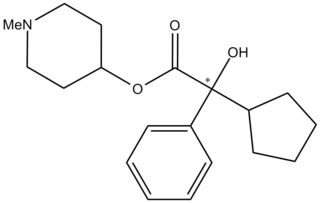
EA-3443 is a potent and long lasting anticholinergic deliriant drug, related to the chemical warfare agent 3-Quinuclidinyl benzilate (QNB). It was developed under contract to Edgewood Arsenal during the 1960s as part of the US military chemical weapons program, during research to improve upon the properties of earlier agents such as QNB.
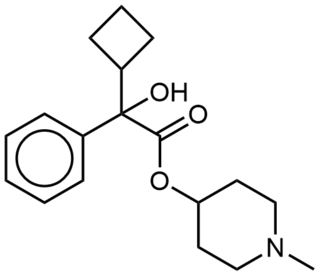
EA-3580 is a potent anticholinergic deliriant drug with a fairly long duration of action, related to the chemical warfare agent 3-Quinuclidinyl benzilate (QNB). It was developed under contract to Edgewood Arsenal during the 1960s as part of the US military chemical weapons program, during research to improve upon the properties of earlier agents such as QNB.

CAR-226,086 is a potent anticholinergic deliriant drug with a fairly long duration of action, related to the chemical warfare agent 3-quinuclidinyl benzilate (QNB). It was developed under contract to Edgewood Arsenal during the 1960s as part of the US military chemical weapons program, during research to improve upon the properties of earlier agents such as QNB.

EA-3834 is a potent anticholinergic deliriant drug with a fairly long duration of action, related to the chemical warfare agent 3-quinuclidinyl benzilate (QNB). It was developed under contract to Edgewood Arsenal during the 1960s as part of the US military chemical weapons program, during research to improve upon the properties of earlier agents such as QNB.

EA-3148 is a "V-series" nerve agent related to the better-known compounds VX and VR. It was studied by both the US and Soviet chemical weapons programmes during the Cold War, and is notable as the only V-series organophosphate nerve agent specifically identified in public domain sources as having a higher absolute potency as an acetylcholinesterase inhibitor than VX. However, both the US and Soviet investigations of the compound concluded that despite its high potency, the physicochemical properties of the substance made it unsuitable for weaponisation, and further research was not conducted.

CAR-301,060 is a potent and long lasting anticholinergic deliriant drug, related to the chemical warfare agent 3-Quinuclidinyl benzilate (QNB). It was developed under contract to Edgewood Arsenal during the 1960s as part of the US military chemical weapons program, during research to improve upon the properties of earlier agents such as QNB.

EA-3990 is a deadly carbamate nerve agent. It is lethal because it inhibits acetylcholinesterase. Inhibition causes an overly high accumulation of acetylcholine between the nerve and muscle cells. This paralyzes the muscles by preventing their relaxation. The paralyzed muscles include the muscles used for breathing.

EA-4056 is a deadly carbamate nerve agent. It is lethal because it inhibits acetylcholinesterase. Inhibition causes an overly high accumulation of acetylcholine between the nerve and muscle cells. This paralyzes the muscles by preventing their relaxation. The paralyzed muscles includes the muscles used for breathing.
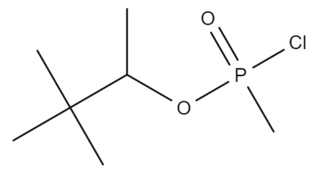
Chlorosoman is a chlorine analog of soman. It is a highly toxic organophosphorus compound and used as the precursor substance for soman nerve agent. Its physical properties are estimated. Soman is insoluble in water, with a boiling point of 223 degrees Celsius and a melting point of -27 degrees Celsius. Chlorosoman is at least 2.5x less toxic than its analogue.
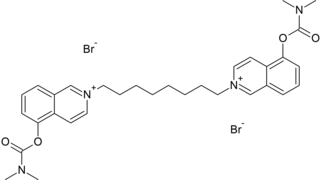
Octamethylene-bis(5-dimethylcarbamoxyisoquinolinium bromide) is an extremely potent carbamate nerve agent. It works by inhibiting the acetylcholinesterase, causing acetylcholine to accumulate. Since the agent molecule is positively charged, it does not cross the blood brain barrier very well.
1,8-Dibromooctane is a chemical compound used in the synthesis of the carbamate nerve agents EA-3990 and octamethylene-bis(5-dimethylcarbamoxyisoquinolinium bromide).

EA-2192 is an extremely toxic degradation product of the VX nerve agent. It is a white solid that is very soluble and stable in water.
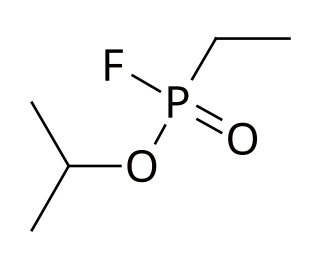
Ethylsarin (GE), also known as EA-1209, TL-1620 or T-2109, is an organophosphate nerve agent of the G-series. It is the ethylphosphonofluoridate analog of sarin.

EA-3966 is a carbamate nerve agent. It is synthesized by reacting 2-dimethylaminomethyl-3-dimethylcarbamoxypyridine with 10-bromodecyltrimethylammonium bromide.

EA-1356 is an organophosphate nerve agent of the G-series. It is highly resistant to enzymatic degradation in the body. The nerve agent was tested at Edgewood Arsenal in Maryland among many other chemicals tested on humans. A novel enzyme was patented by the US Army in 2018 to break down EA-1356. It is a schedule 1 substance by the Chemical Weapons Convention standards. It is under the category of munitions of ML7.b.1.a.

















